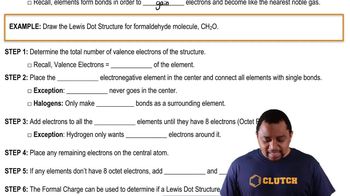(b) What volume of HCl is needed to neutralize 2.87 g of Mg(OH)2?
Ch.4 - Reactions in Aqueous Solution
Chapter 4, Problem 82b
(b) How many milliliters of 0.125 M H2SO4 are needed to neutralize 0.200 g of NaOH?
 Verified step by step guidance
Verified step by step guidance1
Step 1: Write the balanced chemical equation for the neutralization reaction between sulfuric acid (H2SO4) and sodium hydroxide (NaOH). The balanced equation is: \[ \text{H}_2\text{SO}_4 + 2\text{NaOH} \rightarrow \text{Na}_2\text{SO}_4 + 2\text{H}_2\text{O} \]
Step 2: Calculate the number of moles of NaOH. Use the formula: \[ \text{moles of NaOH} = \frac{\text{mass of NaOH (g)}}{\text{molar mass of NaOH (g/mol)}} \] The molar mass of NaOH is approximately 40.00 g/mol.
Step 3: Use the stoichiometry of the balanced equation to find the moles of H2SO4 needed. According to the equation, 1 mole of H2SO4 reacts with 2 moles of NaOH. Therefore, \[ \text{moles of H}_2\text{SO}_4 = \frac{\text{moles of NaOH}}{2} \]
Step 4: Calculate the volume of 0.125 M H2SO4 solution required to provide the moles of H2SO4 calculated in Step 3. Use the formula: \[ \text{Volume (L)} = \frac{\text{moles of H}_2\text{SO}_4}{\text{Molarity of H}_2\text{SO}_4} \]
Step 5: Convert the volume from liters to milliliters by multiplying by 1000, since 1 L = 1000 mL.

Verified video answer for a similar problem:
This video solution was recommended by our tutors as helpful for the problem above.
Video duration:
1mWas this helpful?
Key Concepts
Here are the essential concepts you must grasp in order to answer the question correctly.
Molarity
Molarity (M) is a measure of concentration defined as the number of moles of solute per liter of solution. It is crucial for stoichiometric calculations in chemistry, allowing us to relate the volume of a solution to the amount of substance it contains. In this question, the molarity of sulfuric acid (H2SO4) is given, which will be used to determine how much volume is needed to neutralize a specific mass of sodium hydroxide (NaOH).
Recommended video:
Guided course

Molarity
Neutralization Reaction
A neutralization reaction occurs when an acid reacts with a base to produce water and a salt. In this case, sulfuric acid (H2SO4) will react with sodium hydroxide (NaOH) to form sodium sulfate (Na2SO4) and water. Understanding the stoichiometry of this reaction is essential to determine the exact amounts of reactants needed for complete neutralization.
Recommended video:
Guided course

Lewis Dot Structures: Neutral Compounds
Stoichiometry
Stoichiometry is the calculation of reactants and products in chemical reactions based on the balanced chemical equation. It allows us to convert between grams, moles, and volumes of substances involved in a reaction. In this problem, stoichiometry will be used to relate the mass of NaOH to the moles of H2SO4 required for neutralization, ultimately leading to the calculation of the volume of the acid solution needed.
Recommended video:
Guided course

Stoichiometry Concept
Related Practice
Textbook Question
1
views
Textbook Question
(d) If 45.3 mL of a 0.108 M HCl solution is needed to neutralize a solution of KOH, how many grams of KOH must be present in the solution?
Textbook Question
(a) How many milliliters of 0.120 M HCl are needed to completely neutralize 50.0 mL of 0.101 M Ba(OH)2 solution?
Textbook Question
(c) If 55.8 mL of a BaCl2 solution is needed to precipitate all the sulfate ion in a 752-mg sample of Na2SO4, what is the molarity of the BaCl2 solution?
Textbook Question
The distinctive odor of vinegar is due to acetic acid, CH3COOH, which reacts with sodium hydroxide according to: CH3COOH1aq2 + NaOH1aq2¡ H2O1l2 + NaCH3COO1aq2 If 3.45 mL of vinegar needs 42.5 mL of 0.115 M NaOH to reach the equivalence point in a titration, how many grams of acetic acid are in a 1.00-qt sample of this vinegar?
